11 Best Dropshipping Alternatives For 2024 (Pros + Cons)

Have you been interested in dropshipping but are also curious about a few alternatives that may be a better fit for you?
Maybe you’re already a dropshipper and you want to know what other business models you can tackle.
In this post, you’ll find the best alternatives to dropshipping for ecommerce and online businesses as a whole.
Note: Need help sourcing dropshipping products? Check out Spocket. It can help you source products from various suppliers and integrates with popular ecommerce platforms & marketplaces.
Why look for dropshipping alternatives?
Dropshipping has become a popular business model for starting an online business due to its cheap startup costs and simplicity.
While traditional ecommerce models require you to purchase inventory upfront, store that inventory and process orders on your own (with or without a team), the dropshipping business model doesn’t require you to do any of this.
A service known as a “dropshipping supplier” handles this for you. So, why on earth would anyone look for an alternative to this ecommerce model?
There are a few different reasons:
- The dropshipping niche is becoming quite saturated.
- Consumers have a negative opinion of dropshipping.
- It’s hard to control quality when dropshipping, which can impact your brand’s reputation.
You’ll see these drawbacks mentioned throughout this article as we discuss alternatives and why you may want to choose certain business models over dropshipping.
So, instead of talking more in depth about the disadvantages of dropshipping, let’s get right into our list, which include the following dropshipping alternatives:
- Print on demand
- Dropshipping with a private agent
- White labeling products
- Outsourcing services
- Affiliate marketing
- Selling digital products
- Becoming a wholesale merchant
- Starting an Etsy store
- Traditional ecommerce
- Becoming an influencer
- Freelancing
There’s a definite break between the 9th and 10th list items, which is why we’ve broken this article up into two sections: direct alternatives to dropshipping and other online business models to try.
Let’s get into it.
The best dropshipping alternatives to try
1. Print on demand (POD)
Print on demand is the most obvious alternative to dropshipping. This is because it follows much of the same business model.
Like dropshipping, print-on-demand websites store inventory and process orders on behalf of their customers.
They even go one step further by printing products on your behalf as orders come in.
That’s the primary use case for using a print-on-demand service. It’s the simplest way to start a merchandise business featuring your business’ logo or your designs.
If you use a service like Gelato, you can print your designs on products like t-shirts, long-sleeve shirts, hoodies, drinkware, phone cases, wall art and more.
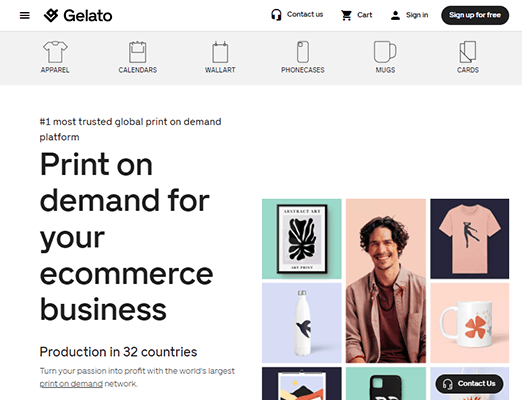
This is what makes print on demand such a great alternative to dropshipping.
Dropshipping products are notorious for being unoriginal. This ties back into our point of dropshipping being an oversaturated business model no matter what niche you target.
Just run a quick search through AliExpress and count the number of times you see the same exact product.

With a print on demand service, you can create original products your customers can’t find anywhere else.
Pros of print on demand
- No upfront costs.
- Cheap.
- Print-on-demand websites like Gelato give you multiple options to pick from for each product type.
- It’s similar enough to dropshipping in that you won’t need to store inventory yourself or process orders on your own.
- Many print-on-demand websites integrate with popular ecommerce platforms like Shopify.
- You can experiment with different designs without wasting money.
Cons of print on demand
- The types of products you can sell are usually limited to apparel and common household products like drinkware.
- There are many reliable print-on-demand websites out there, but like dropshipping, you have no way of controlling the quality of your ecommerce service when you operate it in this way.
- Return and refund options are dictated by the print-on-demand website you use.
2. Dropshipping with a private agent
Dropshipping with a private agent is just dropshipping but with a middleman between you and the dropshipping supplier.
It may seem like a weird business model to consider since services like Spocket and sites like AliExpress already make it easy for you to connect with dropshipping suppliers directly.
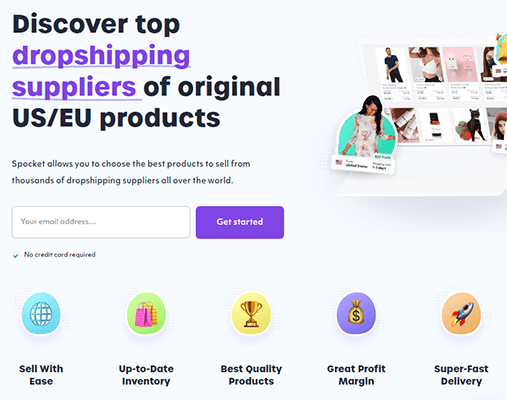
Even so, a dropshipping agent can make the entire process of getting started with dropshipping and running a dropshipping store much easier.
When you work with a dropshipping agent, they don’t just work with one supplier.
Instead, they ask you questions about the types of products you’re looking to sell, and then they take on the task of contacting multiple dropshipping suppliers in search of the best products that meet your requirements.
The rest of the process is similar to the usual dropshipping model you’re used to: the agent purchases the products and charges you as orders come in. You sell the products at higher prices and keep the profits.
Your agent then takes on the role of dropshipping supplier and processes orders and returns on your behalf.
So, while working with a dropshipping agent is quite similar to the typical dropshipping model, it can actually be a better way of going about things as it’s your agent’s job to know which products perform best for your particular niche.
Private dropshipping agents are usually a one-man operation, but you can also hire a professional dropshipping agency instead.
Sourcingbro is a great example of a dropshipping agency. They work with over 200 suppliers and have a full team ready to fulfill orders and keep an eye on quality.
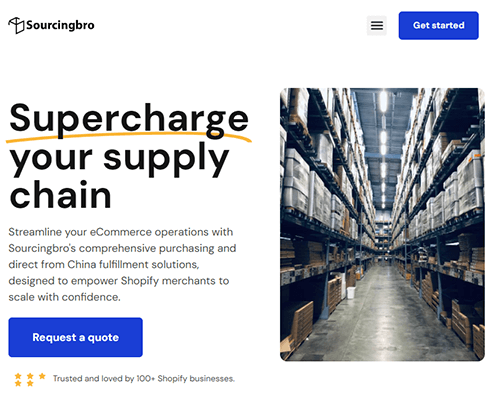
A private dropshipping agent is most likely going to be a freelancer working alone with a small team, but this can be a plus in terms of the amount of time they’re able to dedicate to your business.
Pros of dropshipping with a private agent
- Gives you more potential dropshipping suppliers to work with.
- Has a smaller clientele, so they’re really able to get to know your business and niche more.
- Takes on the task of finding suitable products for you.
- Agents may be able to find high-quality products for you at lower prices.
- Often offer faster order processing and shipping times.
- Many dropshipping agents and agencies help with branding.
Cons
- Whereas large dropshipping suppliers don’t care about order minimums, dropshipping agents may require you to receive a specific number of orders per day consistently.
- The agent or agency’s order fulfillment process may not be automated.
- While products may be cheaper, the service itself can be more expensive.
3. White labeling products
White labeling is an ecommerce model that moves away from dropshipping but still involves you selling other people’s products, so it’s less complicated to start than if you were to sell your own products or purchase existing products from wholesale.
When you white label products, you place your brand on a manufacturer’s product, then sell it in your own store.
This makes it similar to dropshipping but different in that you’re in charge of purchasing inventory upfront, storing it and fulfilling orders yourself.
It can be a decent way to find higher quality products when dropshipping suppliers fall short for a particular product type you’re after.
However, like dropshipping, this ecommerce model is becoming quite saturated with multiple sellers selling the same products under different brand names.
If you search for certain products on Amazon, for example, it’s not uncommon to see the same product being sold under different names.
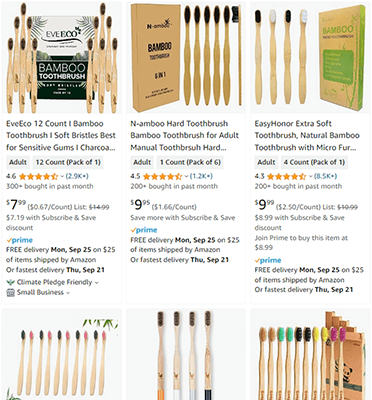
This can make it a much less desirable alternative to dropshipping since it’s more expensive but comes with much of the same issues with competition.
There are white labeling dropshipping suppliers out there, but they’re usually print-on-demand websites, which we’ve already covered, or they specialize in one product.
But know that they do exist if that’s something you’re interested in.
Pros of white labeling
- You can apply your branding to the products you sell.
- A lot of products to choose from.
- Different branding can make the same product appear different to customers.
- Branding allows you to establish brand recognition and build brand loyalty.
- It’s a much easier way to start selling your own products than to have to create one yourself.
Cons of white labeling
- More expensive than dropshipping.
- Requires you to purchase inventory upfront.
- Requires you process and fulfill orders.
- You need a logo and quality designs for product packaging, which means hiring a designer if you’re not able to do this yourself.
4. Outsourcing services
Outsourcing services, also known as “drop servicing,” is a business model in which you market your services to consumers, then hire other service providers to fulfill the request.
This is different from having customers hire your company, then assigning a member of your company to handle their needs.
In drop servicing, the customer often doesn’t know that you intend to hire another service provider to complete their request.
Even so, when you choose quality service providers to work with, it can be a fairly lucrative business model to get into.
It can even help you take on more clients since you can always outsource any additional work you need done.
All in all, it’s a decent way for service-based businesses to get in on the dropshipping craze.
Pros of outsourcing services
- You can accept more work even if your schedule is full.
- Hiring freelancers and contractors lets you take on more clients without hiring actual employees.
- Taking on more work allows you to expand your business. You may even be able to hire freelancers full time.
Cons of outsourcing services
- Outsourcing work means you’ll need to give some of what your clients pay you to your freelancers.
- While you don’t necessarily need to disclose your use of freelancers, some clients may not like the idea of you outsourcing work.
- While it’s a legitimate way to get more work done, hiring freelancers puts you in a “management” position in which you’ll need to direct and critique other people’s work while also handling your own.
5. Affiliate marketing
While you may not consider affiliate marketing to be an alternative of dropshipping on the surface, the two business models are actually quite similar.
This is because they both involve your business generating money by selling another business’ products. You just complete this task in different ways.
In a dropshipping model, you market the products as your own, sell them for more than they’re worth, and collect the profits.
In an affiliate marketing model, you market another business’ products by promoting affiliate links that lead to those products. Then, you collect commissions from the sales your marketing campaigns generate.
Plus, like dropshipping, affiliate marketing is a way to generate revenue without a lot of upfront costs.
Unfortunately, commission rates are dictated by the affiliate marketing program you’re a part of. Plus, there’s a waiting period between 30 and 90 days between when a sale was made and when you receive a commission from it.
The timeframe depends on the company’s return policy since most affiliate programs do not issue commissions for sales that result in returns.
Pros of affiliate marketing
- No upfront costs. Affiliate marketing accounts are free.
- Easy way to generate revenue early on.
Cons of affiliate marketing
- Commission rates are subject to change.
- You don’t always receive compensation for commissions (due to returns).
- It’s difficult to establish your brand in this way since your marketing campaigns revolve around you promoting other people’s products.
6. Selling digital products
This is where we start transitioning away from selling other people’s products and start moving toward considering other ecommerce models as alternatives to dropshipping.
The easiest way to do this is to sell your own original products as digital products.
This could be fiction and nonfiction ebooks, original works of art, art commissions, templates for a variety of different applications, worksheets, icon packs, and more.
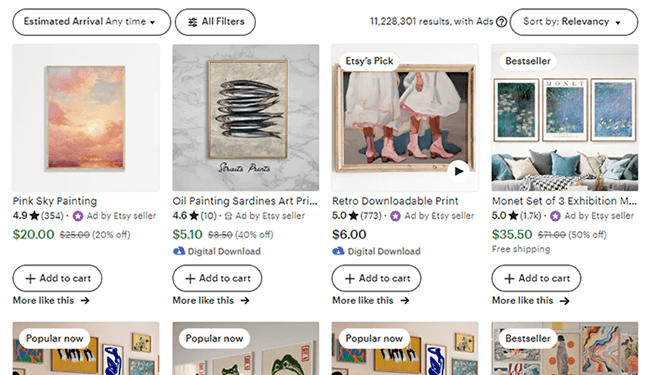
We have a few posts on digital products, including the best digital products to sell online as well as the best digital products to sell on Etsy.
It’s the easiest way to transition away from dropshipping since it doesn’t require you to purchase inventory upfront or physically store inventory and fulfill orders, unless you’re opening yourself up to commissions.
Pros of selling digital products
- Allows you to turn something you’re skilled at into a product.
- Little to no upfront costs.
- No inventory to store or orders to ship.
- Easy to start. There are even entire platforms and services that specialize in helping you sell digital products.
- You can sell an unlimited number of certain digital items.
Cons of selling digital products
- It can be difficult to keep a lid on copyright and piracy issues.
- You can burn out if you open yourself up to commissions.
- There may be more competition in niches related to digital products.
7. Becoming a wholesale merchant
A lot of new business owners won’t consider it since it’s a lot more complicated to set up, but you may find huge success early on by selling to other businesses as a wholesaler.
When you dropship, you’re a retailer selling directly to consumers.
This means each order you process will only include a few products.
When you wholesale, your customers, which include fellow businesses, will order in bulk. This means you can expect each order amount to be quite large.
Unfortunately, as we said before, setting up a wholesale store is a lot more complicated than setting up a dropshipping store.
It’s also more expensive since you’ll need to order bulk amounts directly from manufacturers.
But if you have the funds or the means to create your own supply, becoming a wholesale merchant can be your ticket to starting a successful online business at a much quicker rate.
Wholesale products you can produce yourself include crops, livestock, flowers and plants.
Otherwise, you’ll need to source your products from a manufacturer or manufacture your own products to sell.
Pros
- Orders will be in higher quantities. This means less orders to fulfill and more revenue per order generated.
- You can fulfill a business need for quality products in your niche.
- Easier to market since there’s much less competition in the wholesale field than there is in the retail field.
Cons
- Very expensive to start.
- Requires a little more setup, such as acquiring a wholesale license.
- You’ll need to store a lot of inventory and fulfill orders yourself.
8. Starting an Etsy store
Etsy stores aren’t just for selling digital products like art prints. You can sell any handmade item on Etsy.
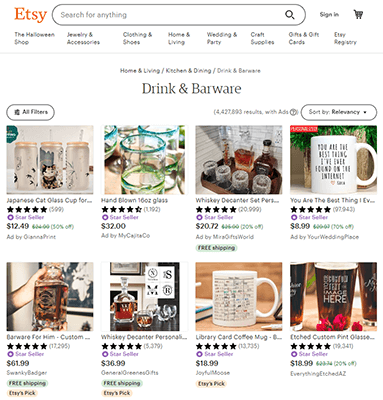
This makes it a decent alternative to dropshipping for artists as it allows you to sell original products on an existing marketplace.
The marketplace aspect of Etsy makes it easier (but not easy) to get noticed early on. You still need to rely on outside marketing, but Etsy’s built-in algorithm makes it easier for your products to gain traction than if you were to market them on social media alone.
The primary benefit a homemade Etsy shop has over dropshipping is similar to the benefit print on demand and white labeling provide: a way for you to sell the same products you were going to dropship but with your own branding attached to them.
Pros of starting an Etsy store
- Allows you to partake in ecommerce by selling your own original products.
- Etsy stores are easy to set up and maintain.
- Etsy’s built-in algorithm makes it easier for you to find your target audience.
- Consumers trust Etsy, at least more than a store they’ve never heard of.
Cons of starting an Etsy store
- A store that relies entirely on handmade products can lead to production issues if you start to experience burnout.
- Requires you to fulfill orders on your own.
- Etsy takes a cut of each sale you make, which wouldn’t happen if you were to sell products on your own website.
- Brand loyalty is attributed to Etsy, not necessarily your individual Etsy store.
- As a marketplace, Etsy is a competitive way to sell handmade products.
9. Traditional ecommerce
Finally, let’s talk about traditional ecommerce.
By “traditional ecommerce,” we mean starting an online store in which all or most products are branded products.
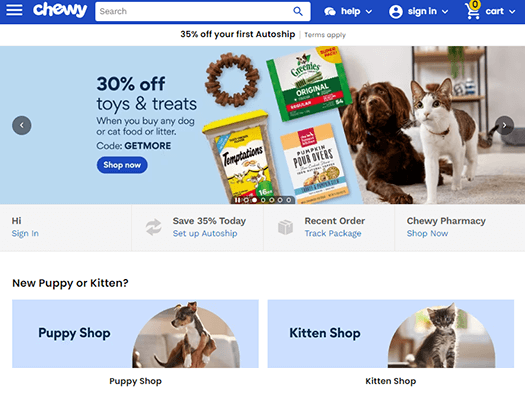
For example, a hardware store may have products from DeWalt, Milwaukee, Stanley, Ryobi and more.
It’s technically a dropshipping alternative, but it’s much more difficult to set up due to the high costs of purchasing inventory in bulk and storing it.
You’ll also be in charge of processing orders and shipping them out to customers, something you don’t need to worry about with dropshipping.
Then, there’s the added complication of choosing a traditional ecommerce niche that doesn’t already have an established store or two where everybody shops.
The beauty of dropshipping products, white labeling products or handmaking products is that you can find a weakness within a specific niche and fulfill it with a “brand new” product.
If your store consists entirely of established products from small to big name brands, you need to target a niche that doesn’t yet have an established store.
When you’re ready, the building of the store is quite straightforward. Ecommerce store builders like Shopify make this part easy and cost effective compared to hiring an agency or a developer.
Pros of traditional ecommerce
- You don’t need to find a problem to solve or come up with a product idea to get started.
- You can choose to only sell quality brands you know bring results.
- It’s entirely possible to start out with a traditional ecommerce model but introduce dropshipping or white labeled products later on.
- Branded products are easier to sell because there’s usually an existing market of customers actively searching for stores to buy them from.
Cons of traditional ecommerce
- Expensive to start.
- You’ll need to worry about inventory and order fulfillment from the get go.
- It’s more difficult (but not impossible) to establish brand recognition this way.
Dropshipping alternatives for starting an online business
10. Becoming an influencer
If you don’t want to start your own dropshipping business or start an ecommerce business of any kind but still want to work online, consider becoming an influencer or content creator.
Platforms like TikTok, YouTube, Instagram and Twitch are great places to get started, but you can also start a podcast or experiment with audiences on Facebook.

An “influencer” is an online business model that allows you to generate revenue through ads, affiliate marketing, subscriptions and sponsorships.
You can even start selling your own products eventually, at which point, you’ll find more success since you’ll have a built-in audience to sell to.
Pros of becoming an influencer
- Requires you to create a lot of content which is fairly easy to do yourself.
- There are a lot of revenue streams to pick from, and you can use multiple.
- You can create content for platforms that have built-in audiences.
- While many creators aren’t making anything, influencer marketing has the potential to generate a lot more revenue than you’d earn in a traditional job.
Cons of becoming an influencer
- It may be awhile before you start generating revenue from your content.
- Many niches are saturated.
- Content views and revenue are unpredictable.
- You’ll be put under a microscope and may have a lot of negative attention directed at you.
11. Freelancing
We covered outsourcing or “drop servicing” earlier. However, if you don’t even have clients to outsource work for, consider starting off by freelancing to grow your portfolio.
If you can do your job as a solo act, consider targeting it as your freelancing niche.
Otherwise, consider what skills you have and how you could potentially market them to businesses or consumers.
Then, find customers. You can use sites like Fiverr and Upwork, Craigslist, or even just plain adding a “job board” phrase to your niche in a Google search.
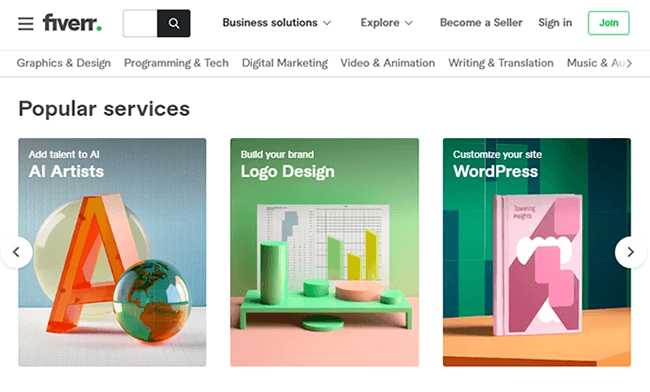
Cold calling or emailing may also be an effective strategy for your niche as can attending events related to it.
You can also start creating content on your website as well as platforms where your audience hangs out as a way to market your freelance services.
It’s a much more involved way to generate revenue online, but it can be a legitimate way to start a side hustle with a skill you already have.
Pros of freelancing
- Easy way to start a side hustle, especially if you already have a marketable skill.
- Flexible work hours and location in comparison to traditional jobs.
- You can potentially earn more than you do in your current role.
Cons of freelancing
- Less stable.
- Not as hands off as dropshipping as a business model.
Final thoughts
A successful dropshipping business is an effective way to start earning money online by selling quality products that have been proven to earn sales.
It’s also become a bit of a controversial ecommerce model, especially for businesses whose product margins are too high.
In a time where consumer trust is at an all-time low, dropshipping becomes an unreliable business model more and more as time goes on.
There are certainly ways to do it properly, but our article has demonstrated quite a few dropshipping alternatives you can resort to if you discover this business model just isn’t a good match for you.
Dropshipping with a private agent and white labeling are most closely related to dropshipping, but outsourcing and even affiliate marketing are great as well.
Affiliate marketing is especially good if you want to start making money from your business’ content or you’ve decided to become an influencer.
Even the print on demand business model may be a more reliable way to dropship products than traditional dropshipping.
But no matter which business model you decide to go with, make sure you do your research so you can reduce the amount of time and money you spend in finding a product to sell and getting it right.
Disclosure: Our content is reader-supported. If you click on certain links we may make a commission.


